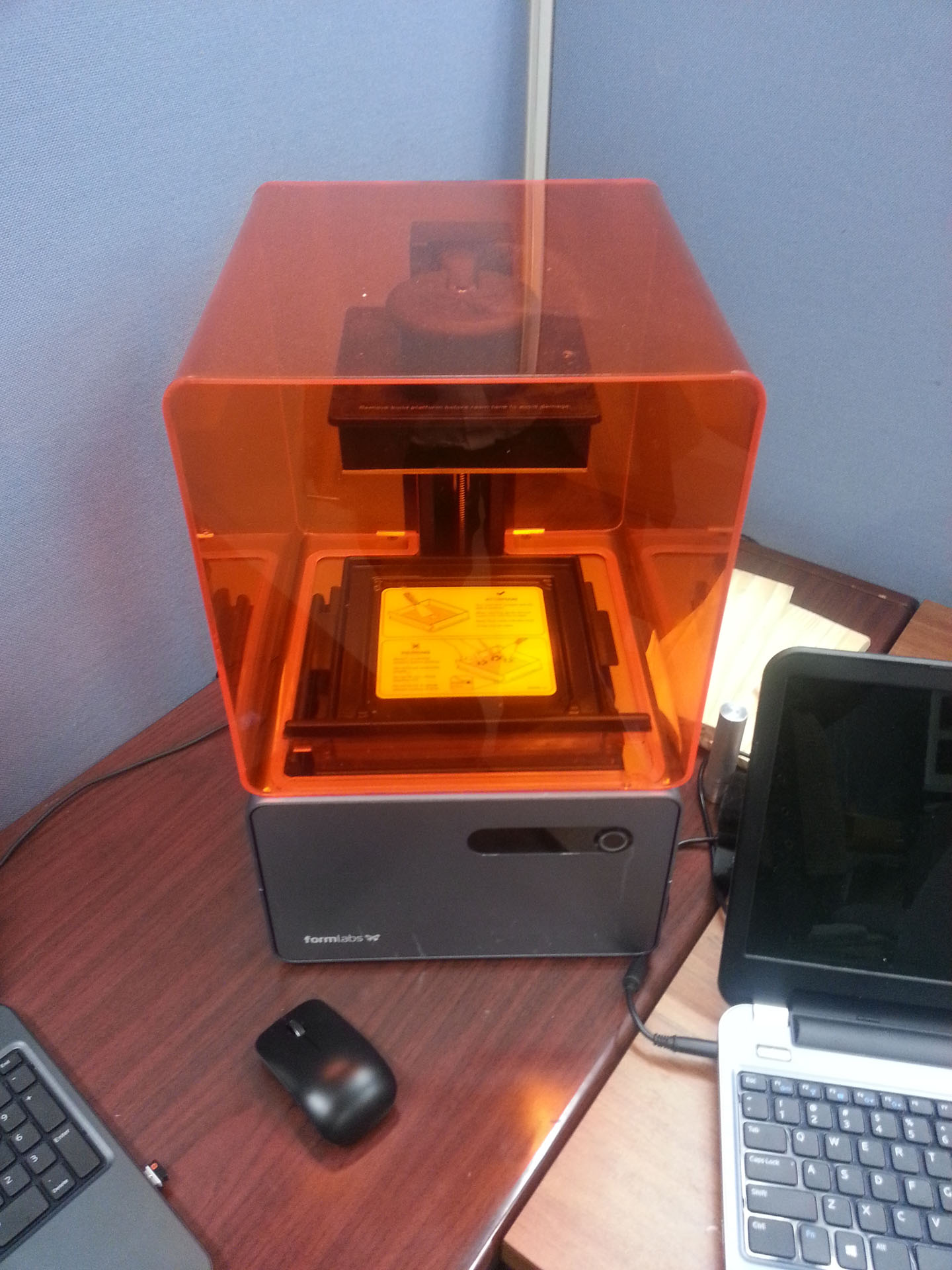Chapter 1. Stereolithography (SLA)
| Process name | Description of method | Machine cost | Upkeep cost | Open source? | Primary distributors |
|---|---|---|---|---|---|
| Stereolithography (SLA) |
Light hardens goop. Limited materials. |
Medium | Medium | Somewhat |
Commercial: 3D Systems Consumer: Formlabs |
Stereolithographic (SLA) 3D printing was initially derived from the lithographic techniques used in the production of microchips. At its most basic, lithography involves a thin layer of a light-sensitive goo (a photoreactive polymer) on top of a silicon wafer. This layer is exposed to a shadowed light such that selected regions (say, those exposed to the light) harden into place while the dark areas remain gooey and removable. This 2D process allows the creation of the very small feature sizes we enjoy in our integrated circuitry, and was certainly employed in the production of several electronic components allowing the composition of this text!
While industrial lithography systems might “shoot” the same patterns of light over and over again, an SLA 3D printer operates by changing the exposure pattern during every layer, so that different regions are hardened as the object is being drawn out of the bath. Figure 1-1 shows an example of this type of printer in the wild, in this case a Formlabs Form1+.

Figure 1-1. A FormLabs Form1+ printer
There are several variations of the SLA process. You can use either a rastering laser to cross-link (harden) your photopolymer, or you can expose the entire layer at once using a projection of the current slice.
Some SLA systems are designed to draw the part out of the supply reservoir, while others are designed to submerge it in the reservoir, scraping a thin layer of liquid material across the surface. Additionally, SLA materials have been adapted for jetting through inkjet print heads derived from those used in 2D printing systems. Systems that employ this approach typically extrude and cure small droplets of material selectively, avoiding the need for a resin bath. These small droplets of material harden before the next layer of droplets are added, in a process similar to the extrusion processes described in Chapter 2.
SLA parts often benefit from curing in an ultraviolet “oven,” which helps to strengthen the part by completing polymerization in regions that might not have had sufficient light to cure completely.
Support structures are absolutely required for SLA parts that include any design with regions that would be free-floating during the printing process (a function of design and orientation). These supports must be removed after the build process, often by hand.
Note
SLA was the first 3D printing method, spawning the use of rapid prototyping as an industry term. It prompted the development of the STL file format used to describe 3D solid models. The man responsible for these developments, Chuck Hall, went on to found 3D Systems.
Benefits, Limitations, and Upkeep
Due to the thin layers used (high resolution), SLA has long been considered to have some of the best surface characteristics of the many available 3D printing methods. This high resolution comes at a fairly high speed, compared to other processes. In general, SLA systems might be slightly faster than other 3D printing methods when building a part of similar volume and layer thickness, because it includes fewer mechanical components, none of which are required to move within the build volume.
Perhaps the biggest drawback of SLA is the material used. Not every liquid will polymerize in the presence of light, and the materials that do are not known for their food safety. Potentially carcinogenic and otherwise not good for you, SLA resins should probably be avoided for printing out your new spork design or other components that people might try to put in their orifices (I realize this sounds odd, but it should be said for everyone’s safety). Depending on the printer used, the feedstock resin might chemically attack its supply vessel, requiring replacement vessels to be purchased over time.
In addition to the equipment and the feedstock resin, additional resin vats and an occasional new light source might be required over time. A UV curing oven is often a useful piece of secondary equipment for finishing. Some hand tools might be necessary to remove supports.
Suppliers and Pricing
In terms of established equipment manufacturers, 3D Systems is the primary commercial SLA supplier (with models typically in the $4,900–60,000 range), while B9Creations and Formlabs were the first to deliver consumer-grade SLA systems (~$3,200–4,600 base).
The past year has seen a number of offerings funded on Kickstarter, including Titan 1, Pegasus Touch, and Peachy Printer. These young startups might yet become players in this space, though at this time there are relatively few small-scale manufacturers delivering printers. A system similar to the FormLabs Form1+ has been released in China, with some of these beginning to appear in the hands of users in the US.
A few DIY systems (some built out of discarded projection systems) have been developed and documented, though the web hosting for these instructions seems to be somewhat inconsistent.
A number of third-party suppliers of resin are beginning to appear, and Feedstock resin typically costs $60–120 per liter, with some variability among suppliers.
Get 3D Printing Primer now with the O’Reilly learning platform.
O’Reilly members experience books, live events, courses curated by job role, and more from O’Reilly and nearly 200 top publishers.

